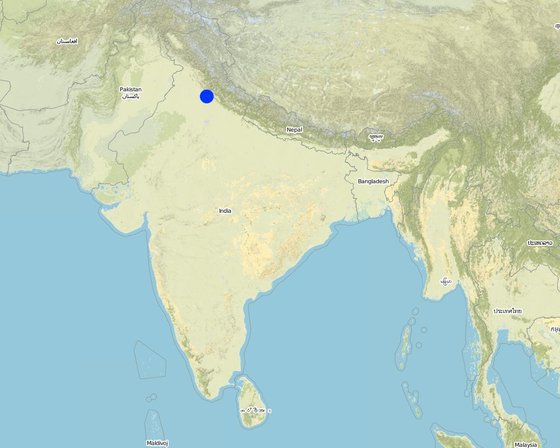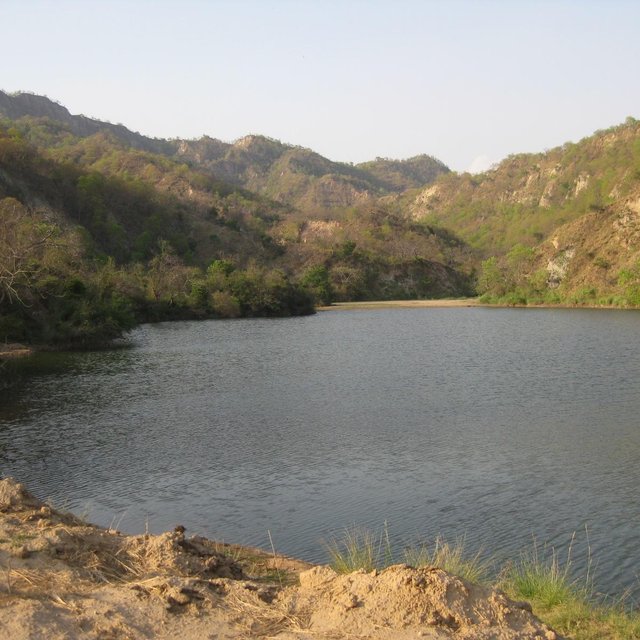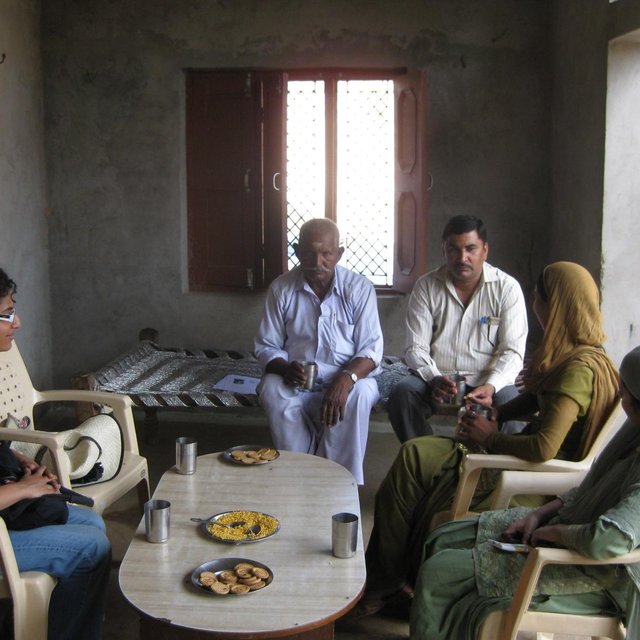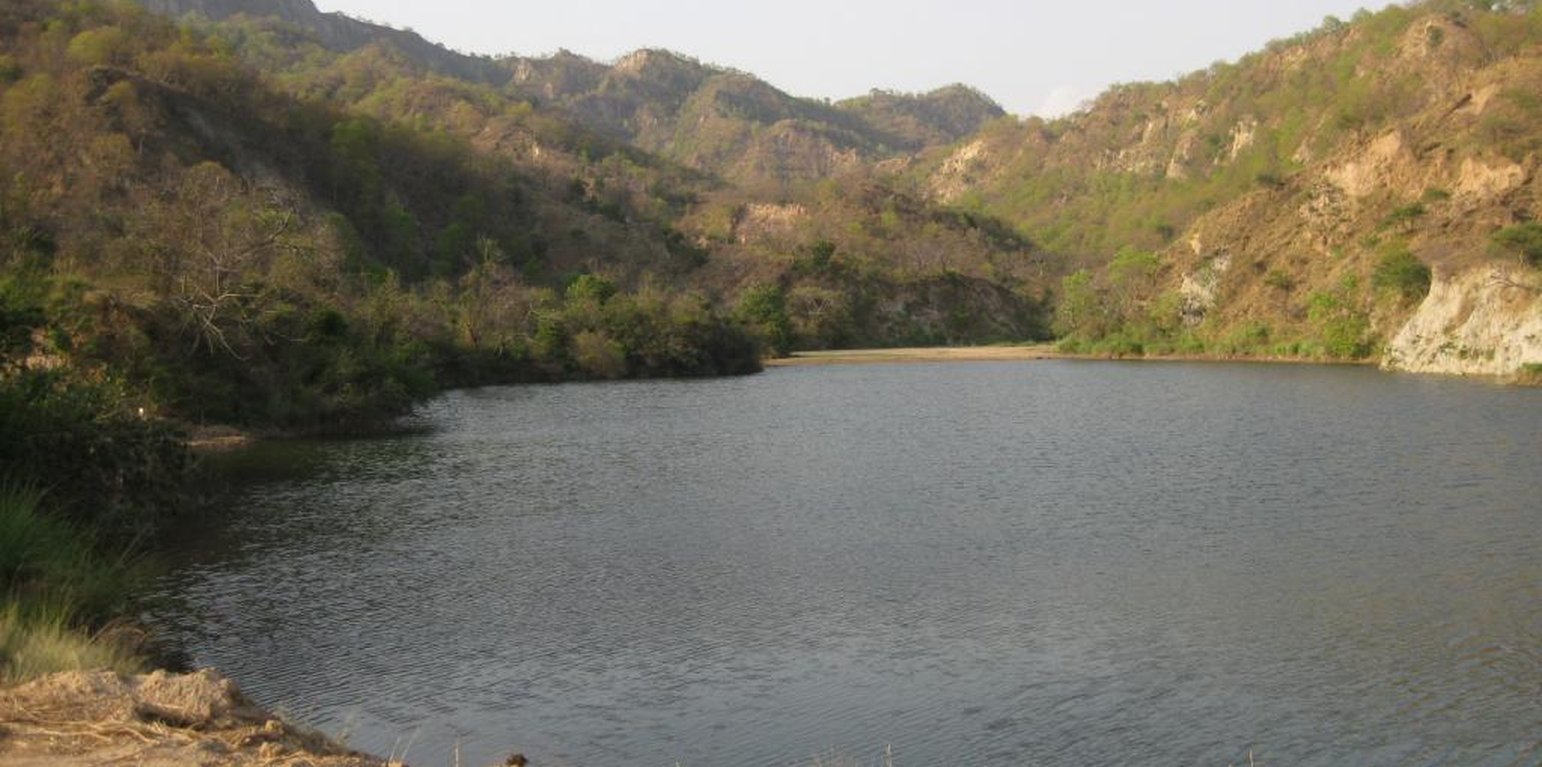Joint forest management
(ប្រទេសឥណ្ឌា)
joint forest management (Revisiting the former QA IND14)
ការពណ៌នា
Joint forest management is a community based program developed in collaboration with the forest department for the protection and management of local forests while providing incentives to the local communities with political and institutional support from the state.
Aims / objectives: Joint forest management (JFM) in India emerged in the 1980s from community initiatives in forest protection. It is an approach that leads to environmental and production benefits through community co-operation in natural resource management. State-supported JFM in Haryana began in 1990 when the Haryana State Government signed an agreement with The Energy and Resources Institute (formerly TERI: Tata Energy Research Institute) - underpinned by financial support from the Ford Foundation - to help establish Hill Resource Management Societies (HRMS). These state sponsored, village level societies are key to the success of JFM, and their links to the State Forest Department are crucial.
Methods: The founding principles of HRMS include appropriate social composition, accountability and conflict resolution and are open to all members of the village communities regardless of gender or caste. Management committees are elected, and each must include at least two women. The HRMS oversee forest catchment management activities by villagers, arrange distribution of irrigation water (where applicable) and liaise with the State Forest Department and TERI. Hill Resource Management Societies derive income from non-timber forest products - particularly from sales of bhabbar grass (used for rope making) - and from water use charges. This income is managed by the HRMS and used for village development and community welfare. Where there is a water harvesting dam all members have the right to claim an equal share of the water, irrespective of whether they have land to irrigate or not.
Stages of implementation: The JFM program was implemented in Thaska with assistance from TERI from 1990 until 2003 where 342 ha of state owned forests were managed. In 2003 TERI, the implementing NGO formally pulled out of Thaska and from 2004 to 2007 there was a gap where JFM continued in the village on its own. In 2007, TERI in partnership with IUCN implemented ‘The Livelihoods and Landscape Strategy’ (LLS) in four villages, including Thaska.
Role of stakeholders: The stakeholders are the villagers, the Haryana forest department and the participating NGOs, in this case TERI. Within villages where JFM is implemented, all adult members (men and women) are eligible for membership within the HRMS. In India, and particularly Haryana, one of the major factors inhibiting women’s participation in JFM activities is the traditional role of women society and attitudes towards them. Women are often marginalized in villages such as Thaska. Thanks to the efforts of the forest department and TERI over the last two decades, the women are more empowered today and attend the HRMS meetings. JFM benefits people with land the most and landless people tend to lose out on such schemes. There is a provision for equal share of water to landless in Thaska. Even though rules for inclusion of water share for landless exist, these are currently not in practice.
ទីតាំង

ទីតាំង: Sadhora range in Yamunanagar district, Haryana, ប្រទេសឥណ្ឌា
ចំណុចយោងភូមិសាស្ត្រនៃទីតាំងជ្រើសរើស
កាលបរិច្ឆេទចាប់ផ្តើម: 1990
ឆ្នាំបញ្ចប់: មិនមាន
ប្រភេទនៃវិធីសាស្ត្រផ្សព្វផ្សាយ
-
ក្រុមប្រពៃណី/ក្រុមជនជាតិភាគតិច
-
អ្នកផ្តួចផ្តើមក្នុងតំបន់/អ្នករុករកឃើញថ្មីៗ
-
ផ្អែកលើគម្រោង/កម្មវិធី

Khol Dam Thaska One of the four dams in Thaska, Khol dam. Currently has water but is not functional. (Fatema Baheranwala)

Meeting the HRMS president in Thaska Clockwise starting from left: Sharlene Shaikh (VU ERM student), Mamraj – HRMS president, Forest guard (Haryana Forest Department), Rubina (LLS field staff) (Fatema Baheranwala)
គោលបំណងនៃវិធីសាស្រ្តផ្សព្វផ្សាយនិងបរិស្ថានអំណោយផល
គោលបំណងនៃវិធីសាស្រ្តផ្សព្វផ្សាយ
The Approach focused mainly on other activities than SLM (Water harvesting, provision of NTFPs to boost incomes. Mainly related to economic activities.)
Develop democratic and powerful Hill Resource Management Societies. - protect the forest land, by means of local participatory governance, and thereby improve the flow of forest products. - boost agricultural productivity through irrigation in village fields from dams in the protected catchments
The SLM Approach addressed the following problems: The main basic problem to be confronted was lack of control over the degradation of forest in the Shivalik Hills which was leading to erosion and siltation of water bodies and a lack of forest products/grazing. - There was no community organization established to address these issues on land that was handed over to the village for management by the Forest Department. Clear felling for agriculture, increasing grazing pressure from large herds of cattle coupled with forest fires and reckless felling replaced the dense forests of Shivaliks by bare hills with thorny bushes. The result was severe erosion on the hills (700T7ha/year) causing serious siltation in lakes/rivers and also affecting agricultural productivity, the primary source of livelihood of the area.
លក្ខខណ្ឌអំណោយផលដល់ការអនុវត្តបចេ្ចកទេសដែលបានប្រើក្នុងវិធីសាស្រ្តផ្សព្វផ្សាយ
-
ក្របខណ្ឌច្បាប់ (សិទ្ធិកាន់កាប់ដីធ្លី កម្មសិទ្ធីប្រើប្រាស់ដីនិងទឹក): The existing land ownership, land use rights / water rights greatly helped the approach implementation: The ownership of the land rests with the state but equal tenure rights of the forest, forest produce, and water to all HRMS members has greatly benefited these societies. Land use rights hinder the approach for the people who are not a part of / excluded from the HRMS.
លក្ខខណ្ឌរាងរាំងដល់ការអនុវត្តបចេ្ចកទេសដែលបានប្រើក្នុងវិធីសាស្រ្តផ្សព្វផ្សាយ
-
សង្គម/វប្បធម៌/ និងតម្លៃនៃសាសនា: - Exclusion of landless - Participation of women low - Lack of local institution for natural resource management.
Treatment through the SLM Approach: - Provision of water sharing to all members of the HRMS, including landless - Awareness raising activities conducted for women. Setting up of women’s self help groups for their empowerment - Set up Hill Resource Management Societies.
-
ភាពអាចរកបាននៃធនធានហិរញ្ញវត្ថុ និងសេវាកម្ម: Inadequate budget from Forest Department for implementation.
Treatment through the SLM Approach: Water charges help to provide finance - but the State Government should assist more.
-
ចំណេះដឹងស្តីពី SLM និងការទទួលបានការគាំទ្រផ្នែកបច្ចេកទេស: Inadequate appreciation/understanding of integrated soil and water conservation/production approach within Forest Department.
Treatment through the SLM Approach: Build awareness in Forest Department.
ការចូលរួមនិងតួរនាតីរបស់ភាគីពាក់ព័ន្ធដែលចូលរួម
ភាគីពាក់ព័ន្ធដែលចូលរួមក្នុងវិធីសាស្រ្តផ្សព្វផ្សាយ និងតួរនាទីរបស់គាត់
| តើមានភាគីពាក់ព័ន្ធ/ភ្នាក់ងារអនុវត្តន៍ណាខ្លះដែលបានចូលរួមក្នុងវិធីសាស្ត្រផ្សព្វផ្សាយ? |
សូមបញ្ជាក់ភាគីពាក់ព័ន្ធ |
សូមពណ៌នាតួនាទីរបស់ភាគីពាក់ព័ន្ធ |
| អ្នកប្រើប្រាស់ដីក្នុងតំបន់/សហគមន៍ |
HRMS members |
All adult members of the village can participate in the HRMS. Women empowerment is an important aspect of the forest policy in Haryana to wean the rural communities of the natural resources. To achieve that the HFD and TERI have set up several women’s SHGs across the region, including three in Thaska. There are differences between the participation of men and women mainly due to the social structure and the ethos of the area. Even though 2 women are mandated to be on the HRMS executive body and 1 woman per household can be a member, their participation is low and women are not always present in the HRMS meetings. Over the last ten years their participation has increased although their presence is mostly passive. They do not feel comfortable voicing their opinions in meetings. They participate actively in SHG meetings. This village/ area has members belonging to minority groups belonging to scheduled castes (SC), as well as religious minorities (Muslim Gujjars). Initially, as each family was eligible for the participation in the HRMS these disadvantaged groups benefitted greatly. However, instances where minorities are excluded are still present indicating that there is room for improvement. |
| អ្នកឯកទេសគ្រប់គ្រងដីប្រកបដោយចីរភាព/ទីប្រឹក្សាបច្ចេកទេសកសិកម្ម |
|
TERI has been involved in the JFM program since 1990 and was responsible for setting up the HRMS in Thaska. |
| អង្គការក្រៅរដ្ឋាភិបាល |
CSWCRTI, TERI |
|
| រដ្ឋាភិបាលថ្នាក់មូលដ្ឋាន |
Forest officers and forest guards of the corresponding Block Office or Range Office. |
|
| រដ្ឋាភិបាលថ្នាក់ជាតិ (អ្នករៀបចំផែនការ អ្នកសម្រេចចិត្ត) |
Haryana forest department |
|
| អង្គការអន្តរជាតិ |
Ford Foundation (no longer involved); IUCN (involved via the LLS program, discussed in section 2.1.1.2) |
|
តួអង្គឈានមុខ៖ {}
Where: TERI – The Energy and Resource Institute; CSWCRTI - Central Soil Water Conservation Research and Training Institute, Chandigarh Within Haryana, JFM was initiated by the CSWCRTI in the 1970s in the village of Sukhomajri. This project was then handed over to the Haryana forest department (HFD). The HFD involved TERI in the implementation of JFM across Haryana in 1990 following the national
ការចូលរួមពីអ្នកប្រើប្រាស់ដីឬសហគមមូលដ្ឋានក្នុងតំណាក់កាលផ្សេងគ្នានៃវិធីសាស្រ្តផ្សព្វផ្សាយ
គ្មាន
អសកម្ម
ការគាំទ្រពីខាងក្រៅ
អន្តរកម្ម
គំនិតផ្តួចផ្តើមដោយខ្ឡួនឯង
ការចាប់ផ្តើម/ការលើកទឹកចិត្ត
Land users participated in awareness raising campaigns and public meetings
ការរៀបចំផែនការ
Land users were consulted and provided information for baseline and feasibility studies, and wealth ranking; Various participatory (PRA) tools like FGDs, survey, pair wise ranking / scoring were used
ការអនុវត្តន៍
Land users responsible for most implementation activities, including provision of labor; Land users were the main agents and TERI played a facilitator role.
ការត្រួតពិនិត្យ និងវាយតម្លៃ
Data / observations for recording changes collected from the land users directly.
Research
Studies carried out using various participatory (PRA) tools like FGDs, survey, pair wise ranking / scoring by TERI with people participation.
គំនូសបំព្រួញ
Flow chart identifying the various stakeholders at different levels for the LLS program
![]()
អ្នកនិពន្ធ: Fatema Baheranwala, Sirisha Indukuri, Sumana Datta
ការសម្រេចចិត្តលើការជ្រើសរើសបច្ចេកទេស SLM
ការសម្រេចចិត្តត្រូវបានធ្វើដោយ
-
អ្នកប្រើប្រាស់ដីដោយខ្លួនឯងផ្ទាល់ (គំនិតផ្តួចផ្តើមដោយខ្លួនឯង)
-
អ្នកប្រើប្រាស់ដី ដោយមានការគាំទ្រពីអ្នកជំនាញឯកទេស SLM
-
គ្រប់ភាគីពាក់ព័ន្ធទាំងអស់ដែលជាផ្នែកនៃវិធីសាស្រ្តផ្សព្វផ្សាយដោយមានការចូលរួម
-
អ្នកជំនាញឯកទេស SLM បន្ទាប់ពីបានប្រឹក្សាយោបល់ជាមួយអ្នកប្រើប្រាស់ដី
-
អ្នកជំនាញឯកទេស SLM តែឯង
-
អ្នកនយោបាយ /អ្នកដឹកនាំ
ការសម្រេចចិត្តត្រូវបានធ្វើដោយផ្អែកលើ៖
-
វាយតម្លៃទៅលើចំណេះដឹងស្តីអំពី SLM ដែលបានចងក្រងជាឯកសារបានត្រឹមត្រូវ (ផ្អែកលើភស្តុតាងជាមូលដ្ឋានដើម្បីសម្រេចចិត្ត)
-
លទ្ធផលបានពីការស្រាវជ្រាវ
-
បទពិសោធន៍ និងគំនិតផ្ទាល់ខ្លួន(ពុំមានចងក្រងជាឯកសារ)
ការគាំទ្របច្ចេកទេស ការកសាងសមត្ថភាព និងការគ្រប់គ្រងចំណេះដឹង
សកម្មភាព ឬសេវាកម្មខាងក្រោមបានប្រើជាផ្នែកនៃវិធីសាស្ត្រផ្សព្វផ្សាយ
-
ការកសាងសមត្ថភាព/ បណ្តុះបណ្តាល
-
សេវាផ្តល់ប្រឹក្សាយោបល់
-
ការពង្រឹងសមត្ថភាពស្ថាប័ន (ការអភិរឌ្ឍន៍អង្គភាព)
-
ការត្រួតពិនិត្យ និងវាយតម្លៃ
-
ការស្រាវជ្រាវ
ការកសាងសមត្ថភាព/ ការបណ្តុះបណ្តាល
ការបណ្តុះបណ្តាលបានផ្តល់ដល់អ្នកពាក់ព័ន្ធដូចខាងក្រោម
-
អ្នកប្រើប្រាស់ដី
-
បុគ្គលិកចុះទីវាល/អ្នកផ្តល់ប្រឹក្សាយោបល់
ទម្រង់នៃការបណ្តុះបណ្តាល
-
អនុវត្តន៍ជាមួយការងារ
-
ពីកសិករទីកសិករ
-
ទីតាំងបង្ហាញ
-
ការប្រជុំជាសាធារណៈ
-
វគ្គបណ្តុះបណ្តាល
មុខវិទ្យាដែលបានបញ្ចូល
SHGs: Capacity building, saving money, and generating additional income. HRMS – awareness raising of existing services and training regarding daily functioning of HRMS, record maintenance, etc., TERI was involved in training the forest department under the JFM program, but those activities were stopped after 2004.
សេវាកម្មប្រឹក្សា
សេវាកម្មប្រឹក្សាត្រូវបានផ្តល់ឱ្យ
-
នៅលើដីរបស់អ្នកប្រើប្រាស់ដី
-
នៅមជ្ឈមណ្ឌលជាអចិន្ត្រៃ
Name of method used for advisory service: Provide support to the HRMS and the SHG; Key elements: Improve day to day functioning to improve transparency and increase participation. , Support record maintenance.
Advisory service is inadequate to ensure the continuation of land conservation activities; Land users are aware of their responsibilities to maintain and repair existing SWC structures but need more training and support from the forest department or NGOs in order to carry out these activities.
ការពង្រឹងស្ថាប័ន
ស្ថាប័នត្រូវបានព្រឹង/ បង្កើត
-
ទេ
-
បាទ/ច៎ា តិចតួច
-
បាទ/ច៎ា ជាមធ្យម
-
បាទ/ច៎ា បានខ្លាំង
នៅកម្រិតដូចខាងក្រោម
-
ថ្នាក់មូលដ្ឋាន
-
កម្រិតថ្នាក់តំបន់
-
កម្រិតថ្នាក់ជាតិ
ពិពណនាស្ថាប័ន៖ តួនាទី និងការទទួលខុសត្រូវ សមាជិក ។ល។
ប្រភេទនៃការគាំទ្រ
-
ហិរញ្ញវត្ថុ
-
ការកសាងសមត្ថភាព/ បណ្តុះបណ្តាល
-
សម្ភារៈ
សេចក្តីលម្អិតបន្ថែមទៀត
The local institutions have been supported through training and capacity building over the last two decades.
ការត្រួតពិនិត្យ និងវាយតម្លៃ
bio-physical aspects were ad hoc monitored by project staff through measurements
technical aspects were regular monitored by project staff through measurements
socio-cultural aspects were regular monitored by project staff through observations
economic / production aspects were regular monitored by project staff through observations
area treated aspects were ad hoc monitored by project staff through observations
no. of land users involved aspects were regular monitored by project staff through observations
management of Approach aspects were regular monitored by project staff through observations
There were several changes in the Approach as a result of monitoring and evaluation: There were several changes in the approach. Internal reviews are carried out every one or two years: there have been several changes proposed and carried out as a result. These changes were in aspects of sharing water irrigation, and in methods of utilizing income derived from forest products - especially bhabbar grass (Eulaliopsis binata).
ការស្រាវជ្រាវ
ការស្រាវជ្រាវពាក់ព័ន្ធនឹងប្រធានបទខាងក្រោម
-
សង្គមវិទ្យា
-
សេដ្ឋកិច្ច/ទីផ្សារ
-
បរិស្ថានវិទ្យា
-
បច្ចេកវិទ្យា
Research was carried out by TERI covering various aspects of the JFM program, the institutional set up, NTFP value chains, wealth ranking of the villages, etc., As LLS was an action research project, it involved a considerable amount of on-farm research. Some results were made available through TERI and by the Haryana forest department (HFD).
Research was carried out on-farm
ការផ្តល់ថវិកា និងការគាំទ្រសម្ភារពីខាងក្រៅ
ថវិកាប្រចាំឆ្នាំគិតជាដុល្លាអាមេរិកសម្រាប់ផ្នែក SLM
-
< 2,000
-
2,000-10,000
-
10,000-100,000
-
100,000-1,000,000
-
> 1,000,000
Precise annual budget: មិនមាន
Approach costs were met by the following donors: government (The government contributes in constructing SWC structures in the JFM forests. Maintenance and repair); international non-government (Ford foundation is no longer active in JFM and JFM does not receive any external funding in Haryana ); local community / land user(s) (Carry out maintenance and repair of the water harvesting and soil and water conservation structures.)
សេវាកម្ម និងការលើកទឹកចិត្តខាងក្រោមត្រូវបានផ្តល់ដល់អ្នកប្រើប្រាស់ដី
-
ការគាំទ្រផ្នែកហិរញ្ញវត្ថុ / សម្ភារៈដែលបានផ្តល់ទៅឱ្យអ្នកប្រើប្រាស់ដី
-
បដិភាគសម្រាប់ធាតុចូលជាក់លាក់
-
ឥណទាន
-
ការលើកទឹកចិត្ត ឬវិធីសាស្ត្រដ៏ទៃទៀត
ការគាំទ្រថវិការ/ សម្ភារដែលបានផ្តល់ដល់អ្នកប្រើប្រាស់ដី
ផ្តល់ហិរញ្ញវត្ថុមួយផ្នែក
ផ្តល់ហិរញ្ញវត្ថុទាំងស្រុង
សម្ភារៈ: ម៉ាស៊ីន
bulldozers are used to construct dams
កំលាំងពលកម្មដោយអ្នកប្រើប្រាស់ដីគឺ
-
ដោយស្ម័គ្រចិត្ត
-
ធ្វើការងារប្តូរជាអាហារ
-
បង់ជាសាច់ប្រាក់
-
ផ្តល់ជារង្វាន់តាមរយៈការគាំទ្រជាសម្ភារៈ
ឥណទាន
-
លក្ខខណ្ឌ៖ Interest rate charged: 2.0%; repayment conditions: SHG Women. The money contributed and saved by the SHG women is used for inter-loaning amongst themselves with an interest rate of 2% per month..
Interest was lower than market rate.
-
អ្នកផ្តល់ឥណទាន៖ មិនមាន
-
អ្នកទទួលឥណទាន៖ Women from the self help groups
ការវិភាគផលប៉ះពាល់ និងសេចក្តីសន្និដ្ឋាន
ឥទ្ធិពលនៃវិធីសាស្រ្តផ្សព្វផ្សាយ
ទេ
បាទ/ច៎ា បន្តិចបន្តួច
បាទ/ច៎ា ជាមធ្យម
បាទ/ច៎ា បានខ្លាំង
តើវិធីសាស្ត្រផ្សព្វផ្សាយជួយអ្នកប្រើប្រាស់ដីដើម្បីអនុវត្តន៍ និងថែទាំបច្ចេកទេស SLM?
The creation of HRMS led to economic, ecological and social improvements. Forest canopy was restored, and tree density increased. Soil erosion reduced and water management improved. Provision of water boosted agricultural productivity provision of grasses mainly in the first decade enhanced incomes.
តើវិធីសាស្ត្រផ្សព្វផ្សាយនេះផ្តល់សិទ្ធិអំណាចដល់សង្គមនិងសេដ្ឋកិច្ចដែលក្រុមមិនទទួលបានផលប្រយោជន៍?
For the marginalized landless communities the provision of NTFPs improved their incomes. Furthermore, participation in the HRMS meant equal rights that empowered these groups. Yet, poverty persists.
តើវិធីសាស្ត្រផ្សព្វផ្សាយបានឱ្យប្រសើរឡើងនូវបញ្ហាកាន់កាប់ដីធ្លី/សិទ្ធិអ្នកប្រើប្រាស់ដែលរារាំងដល់ការអនុវត្ត SLM?
Typical case of common pool resource problems: The people within these villages were over-utilizing their resources and thus giving access rights to land and water ensured that people felt a sense of ownership and derived benefits from these resources, which motivated them to protect them.
Did other land users / projects adopt the Approach?
The original experiment in Sukhomajri has been replicated in 60 other villages within Ambala and Yamunagar Districts - and further afield in Haryana and India generally. The women in Thaska were eager to form SHGs after observing other SHGs in practice.
ការជំរុញទឹកចិត្តសំខាន់បំផុតនៃអ្នកប្រើប្រាស់ដីក្នុងការអនុវត្ត SLM
-
បង្កើនផលិតកម្ម
-
បង្កើនប្រាក់ចំណេញ (សមត្ថភាព) បង្កើនអត្រាចំណេញ
-
ការកាត់បន្ថយការធ្លាក់ចុះគុណភាពដី
-
កាត់បន្ថយហានិភ័យនៃគ្រោះមហន្តរាយ
-
កាត់បន្ថយទំហំការងារ
-
ការចំណាយ/បដិភាគ
-
ច្បាប់ និងបទបញ្ជា (ផាកពិន័យ)/ការប្រតិបត្តិ
-
កិត្តិនាម សម្ពាធសង្គម/ការផ្សាភ្ជាប់ទៅនឹងសង្គម
-
ការផ្សារភ្ជាប់ទៅនឹងចលនា/គម្រោង/ក្រុម/បណ្តាញ
-
ពង្រឹងស្មារតីផ្នែកបរិស្ថាន
-
ទម្លាប់ និងជំនឿ សីលធម៌
-
លើកកម្ពស់ចំណេះដឹង និងជំនាញ SLM
-
ការកែលម្អសោភ័ណ្ឌភាព
-
ការកាត់បន្ថយជម្លោះ
-
well-being and livelihoods improvement
និរន្តរភាពនៃសកម្មភាពផ្សព្វផ្សាយ
តើអ្នកប្រើប្រាស់ដីអាចបន្តដោយនិរន្តរភាពនូវអ្វីដែលបានអនុវត្តតាមរយៈការផ្សព្វផ្សាយ (ដោយមិនមានការគាំទ្រពីខាងក្រៅ)?
សេក្តីសន្និដ្ឋាន និងមេរៀនបទពិសោធន៍
ភាពខ្លាំង: ទស្សនៈអ្នកប្រើប្រាស់ដី
-
The condition of managed forests has improved. Forests have regenerated and forest cover and tree density have improved. (How to sustain/ enhance this strength: Ensure that people are motivated to protect and manage their forests. )
-
The JFM program brought the forest department and the local communities closer. The FD and the local communities have learnt to work together and in many areas have a congenial working relationship. (How to sustain/ enhance this strength: Continue existing activities)
ភាពខ្លាំង: ទស្សនៈរបស់អ្នកចងក្រង ឬបុគ្គលសំខាន់ផ្សេងទៀត
-
Direct and indirect benefits of JFM through agriculture and livestock rearing, greatly improved income of participating families. (How to sustain/ enhance this strength: Better access to markets and training of value addition on NTFPs required.)
-
The institutional set up of JFM is strong in several villages. The HRMS function in a democratic manner and people are aware of their rights and responsibilities. For the participating members, the benefit sharing was considered fair and equitable. (How to sustain/ enhance this strength: Continue to build capacity of these institutions. Guide and support the HRMS to ensure that they continue to grow and function in a democratic manner. )
-
JFM had a tangible impact on tenure rights. The creation of HRMS established a healthy relationship between the FD and the local communities. (How to sustain/ enhance this strength: Make the JFM policy flexible – where JFM communities are performing well give them greater responsibilities and rights.)
-
Women and minorities are more empowered today, through schemes such as the creation of SHGs and participation in HRMS meetings. The creation of SHGs has given women access to micro credit. (How to sustain/ enhance this strength: Continue to create awareness among women.)
ចំណុចខ្សោយ/ គុណវិបត្តិ/ ហានិភ័យ : ទស្សនៈអ្នកប្រើប្រាស់ដីវិធីដោះស្រាយ
-
Incentives for participation are not sufficient. Local communities are concerned that the younger generation will continue these activities due to the dearth of incentives.
Land users in different villages have different needs from their forests. JFM policy needs to be reformed. Policy should be flexible to be able to tailor it to the specific needs of the land users to provide them with the appropriate incentives to ensure participation.
-
Women lack training/ tools to develop skills to engage in income generation activities
Conduct training sessions and distribute tools to women to allow them to engage in income generation activities.
-
Due to the improvement in forest quality the number of wild animals in these forests has increased. Recently animals are entering the agricultural fields and destroying the crops.
The villagers would like to fence the forest area, however carrying out enrichment planting in the forest by planting edible plants and shrubs and either constructing trenches around the forest or planting vegetative barriers that can reduce the movement of the animals to the village lands is recommended.
ចំណុចខ្សោយ/ គុណវិបត្តិ/ ហានិភ័យ : ទស្សនៈរបស់អ្នកចងក្រង ឬបុគ្គលសំខាន់ផ្សេងទៀតវិធីដោះស្រាយ
-
Huge gaps in market access and value addition for NTFPs.
Possible solutions included the removal of middle men, establishing links to the markets and training them for value addition of their products to boost their incomes.
-
Biodiversity of the forests is decreasing due to the spread of an invasive species, Lantana camara, that threatens to crowd out valuable species and is susceptible to forest fires.
Train land users in culling of Lantana camara as well as making NTFPs using the shrub. Engage in forest maintenance and clearance of paths to avoid forest fires.
-
Malfunctioning dams have instigated the proliferation of tube wells across the village, which threatens to lower the water table.
Ensure that sufficient funds are available to carry out regular dam maintenance and repair. Regulate tube wells by including permission for setting up tube wells in the joint management agreement.
-
Multiple programs that set up parallel institutions for resource management means less attention is paid to existing institutions and results in the inefficient utilization of resources.
There is a need to synergize and focus on the goals of these programs rather than the means of implementation.
-
Funding for JFM has drastically reduced.
There is an opportunity to merge JFM activities with regional, national and international programs to channel funds through JFM committees for forest related activities.
-
Participation of women is still passive.
Continue to create awareness among women.
ឯកសារយោង
កាលបរិច្ឆេទនៃការអនុវត្ត: 26 ខែ សីហា ឆ្នាំ 2011
កែតម្រូវចុងក្រោយ: 17 ខែ កក្កដា ឆ្នាំ 2017
បុគ្គលសំខាន់ៗ
-
Sumana Datta (sdatta@teri.res.in) - អ្នកជំនាញឯកទេស SLM
-
Sirisha Indukuri (sirisha@teri.res.in) - អ្នកជំនាញឯកទេស SLM
-
Fatema Baheranwala (f.baheranwala@student.vu.nl) - អ្នកជំនាញឯកទេស SLM
ការពណ៌នាលម្អិតក្នុងប្រព័ន្ធគ្រប់គ្រងទិន្នន័យរបស់វ៉ូខេត
ឯកសារនេះត្រូវបានសម្របសម្រួលដោយ
ស្ថាប័ន៖
- Tata Energy Research Institute TERI (Tata Energy Research Institute TERI) - ប្រទេសឥណ្ឌា
- VU University Amsterdam (VU University Amsterdam) - ប្រទេសហូឡង់
គម្រោង
ឯកសារយោងសំខាន់ៗ
-
IBRAD (2006). Study on effectiveness and functioning of joint forest management committees in India. A project of National Afforestation and Eco-development Board, Ministry of Environment and Forests, Government of India. Conducted by Indian Institute of Bio-Social Research & Development (IBRAD), Kolkata, India :
-
ISFR (2009). India State of Forest Report 2009 – Haryana. Forest Survey of India. Ministry of Environment and Forests, Government of India Retrieved from on June 21 2011:
-
Kanetkar, R.S., Varalakshmi, V. (1994). Women in Godam - Haryana: A gender and caste based study on conservation of forest resources. Joint forest management series no. 13. Haryana forest department and Tata Energy Research Institute (TERI), New Delhi:
-
Kaul, O.N., Dwivedi, B.N., Shah, V. (1995 a). Ecological revival of Haryana Siwaliks through community participation. Joint Forest Management series no. 17. Haryana forest department and Tata Energy Research Institute (TERI), New Delhi:






